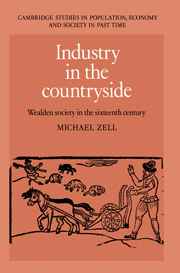Book contents
- Frontmatter
- Contents
- List of figures
- List of tables
- Acknowledgements
- List of abbreviation
- 1 Introduction
- 2 Landholding, inheritance and the local land market
- 3 Demographic movements, household structure and geographical mobility
- 4 The Wealden agrarian regime
- 5 Occupational structure and levels of wealth in the Weald
- 6 The textile industry in the Weald
- 7 Clothiers and capitalism
- 8 The Weald and ‘proto-industrialization’
- Bibliography
- Index
- Cambridge Studies in Population, Economy and Society in Past Time
2 - Landholding, inheritance and the local land market
Published online by Cambridge University Press: 13 October 2009
- Frontmatter
- Contents
- List of figures
- List of tables
- Acknowledgements
- List of abbreviation
- 1 Introduction
- 2 Landholding, inheritance and the local land market
- 3 Demographic movements, household structure and geographical mobility
- 4 The Wealden agrarian regime
- 5 Occupational structure and levels of wealth in the Weald
- 6 The textile industry in the Weald
- 7 Clothiers and capitalism
- 8 The Weald and ‘proto-industrialization’
- Bibliography
- Index
- Cambridge Studies in Population, Economy and Society in Past Time
Summary
At the very heart of the pre-industrial – and proto-industrial – economy was the land. Even though the Kentish Weald was a manufacturing region during the sixteenth and seventeenth centuries, it nevertheless is crucial to understand the basic structures of landholding and land use. Therefore this study must begin by considering land ownership and the local land market. For if the connections between rural industry and contemporary agriculture are to be understood, historical analysis must move from the latter to the former: Wealden clothmaking and ironworking operated within a pre-existing framework of landholding and farming.
Small landowners were thick on the ground in the sixteenth-century Weald. And, although many estates tended to grow larger through a process of amalgamation by purchase and through marriages, consolidation was constantly being reversed by the stubborn adherence of most owners to the Kentish custom of dividing their lands among their heirs. Only at the very top of the landholding hierarchy – among the gentry – and at the bottom – the smallholders – was partition not the normal response of Wealden landowners on their deathbeds. This cyclical process was strengthened in the course of the sixteenth century as rural prosperity allowed those with land, and perhaps with a craft as well, to purchase additional parcels in what was an active land market, especially from the 1540s. At the same time the demographic trends (discussed at greater length in chapter 3) were such that an increasing share of these small estate builders and inheritors had more than one male heir.
- Type
- Chapter
- Information
- Industry in the CountrysideWealden Society in the Sixteenth Century, pp. 10 - 51Publisher: Cambridge University PressPrint publication year: 1994
- 1
- Cited by

